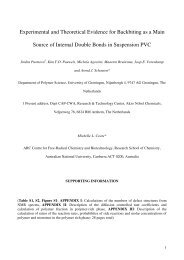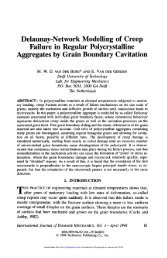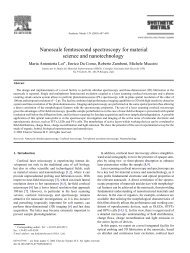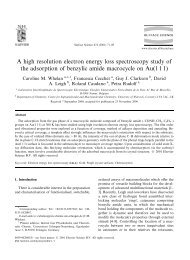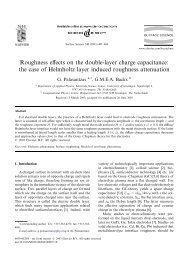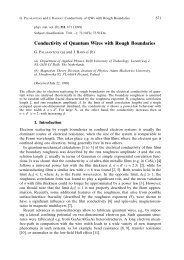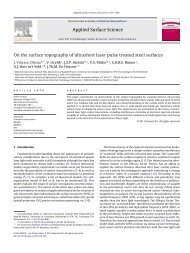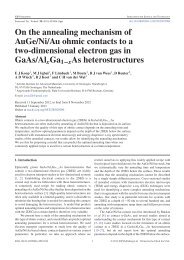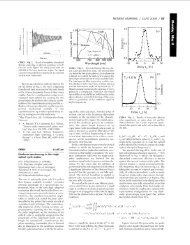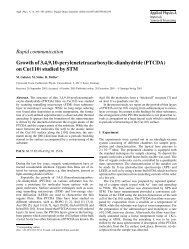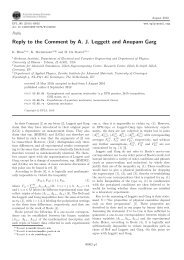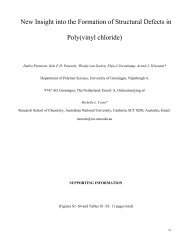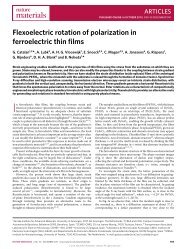Double-layered Aurivillius-type ferroelectrics with magnetic moments
Double-layered Aurivillius-type ferroelectrics with magnetic moments
Double-layered Aurivillius-type ferroelectrics with magnetic moments
Create successful ePaper yourself
Turn your PDF publications into a flip-book with our unique Google optimized e-Paper software.
Materials Research Bulletin 45 (2010) 546–550<br />
Contents lists available at ScienceDirect<br />
Materials Research Bulletin<br />
journal homepage: www.elsevier.com/locate/matresbu<br />
<strong>Double</strong>-<strong>layered</strong> <strong>Aurivillius</strong>-<strong>type</strong> <strong>ferroelectrics</strong> <strong>with</strong> <strong>magnetic</strong> <strong>moments</strong><br />
A.B. Missyul a, *, I.A. Zvereva a , T.T.M. Palstra b , A.I. Kurbakov c<br />
a Department of Chemistry, Saint-Petersburg State University, 198504, Universitetskiy pr., 26, St.-Petersburg, Russia<br />
b Solid State Chemistry Laboratory, Zernike Institute for Advanced Materials, University of Groningen, 9747AG Groningen, The Netherlands<br />
c Petersburg Nuclear Physics Institute RAS, 188300 Gatchina, St.-Petersburg region, Russia<br />
ARTICLE<br />
INFO<br />
ABSTRACT<br />
Article history:<br />
Received 8 October 2009<br />
Received in revised form 7 January 2010<br />
Accepted 1 February 2010<br />
Available online 6 February 2010<br />
Keywords:<br />
A. Ceramics<br />
B. Chemical synthesis<br />
C. Neutron scattering<br />
C. X-ray diffraction<br />
D. Ferroelectricity<br />
We have synthesized the double-layer <strong>Aurivillius</strong> phase Bi 2 LnNbTiO 9 where Ln = Nd–Gd, Bi. All<br />
compounds adopt the orthorhombic polar space group A2 1 am. The <strong>magnetic</strong> Ln-ion occupies the<br />
cuboctahedral position in the middle of the perovskite double-layer, and thus controls the octahedral tilt<br />
of the perovskite block. This tilt modifies the ferroelectric displacement of the (Nb,Ti) towards the<br />
octahedral faces. This provides a mechanism to systematically modify the polarization. Mn-substitution<br />
on the (Nb,Ti) site for Ln = Bi is homogeneous up to x = 0.2. The <strong>magnetic</strong> <strong>moments</strong> of Ln do not order<br />
down to 5 K.<br />
ß 2010 Elsevier Ltd. All rights reserved.<br />
1. Introduction<br />
Modern technology makes use of materials <strong>with</strong> extraordinary<br />
electrical and <strong>magnetic</strong> properties. The perovskite-<strong>type</strong> ceramics<br />
take a prominent position. Perovskites are built from corner<br />
sharing octahedra which form a three-dimensional structure.<br />
They may contain most of the metals in different oxidation<br />
states and form solid solutions allowing to create materials <strong>with</strong><br />
different properties. This allows to tune their functionality<br />
including magnetism or ferroelectricity. Related materials are<br />
<strong>layered</strong> perovskite-like compounds such as Ruddlesden–Popper<br />
[1], <strong>Aurivillius</strong> [2] or Dion–Jacobson phases [3]. Here, single or<br />
multiple perovskite blocks are separated by layers of ions or<br />
different blocks.<br />
One of the interesting properties observed for perovskites is<br />
multiferroism. Multiferroics are materials in which two or all three<br />
of the properties ferroelectricity, ferromagnetism, and ferroelasticity<br />
occur in the same phase [4]. Due to practical reasons the<br />
meaning of the term ‘multiferroism’ has changed and now it often<br />
means simultaneous occurrence of ferroelectricity and any <strong>type</strong> of<br />
<strong>magnetic</strong> ordering (ferro-, antiferro- or ferrimagnetism). Specific<br />
device applications that have been suggested for such materials<br />
include multiple-state memory elements, electric-field-controlled<br />
* Corresponding author. Tel.: +7 812 4284051; fax: +7 812 4286939.<br />
E-mail address: lab2193@gmail.com (A.B. Missyul).<br />
ferro<strong>magnetic</strong> resonance devices, and transducers <strong>with</strong> <strong>magnetic</strong>ally<br />
modulated piezoelectricity.<br />
The first multiferroic compound, Ni 3 B 7 O 13 I was discovered in<br />
1966 [5] but until now the number of multiferroics is very small.<br />
Theoretical analysis by Hill [6] shows that in the ABO 3 perovskites<br />
general demands for ferroelectricity and ferromagnetism are<br />
opposite: the electron configuration of the B ion should be d 0 for<br />
<strong>ferroelectrics</strong> and d n (n 6¼ 0) for <strong>magnetic</strong> properties. Conventionally,<br />
there are two ways to solve this problem: one can either<br />
synthesize solid solutions of ferroelectric and <strong>magnetic</strong> phases or<br />
use subtle effects originating from the A ion. Recently various novel<br />
approaches have been suggested [7].<br />
Layered perovskite-like oxides were not considered as possible<br />
multiferroics. However, most of the <strong>Aurivillius</strong> phases are<br />
ferroelectric and substitution of the non-<strong>magnetic</strong> ions by<br />
<strong>magnetic</strong> ones in these phases might lead to the formation of<br />
multiferroic compounds. The present article deals <strong>with</strong> two<br />
possible ways to prepare such compounds: the substitution of<br />
Bi 3+ for Ln 3+ and Ti 4+ for Mn 4+ in Bi 3 NbTiO 9 . The resulting<br />
compositions Bi 2 LnNbTiO 9 and Bi 3 NbTi 1 x Mn x O 9 as well as mixed<br />
Bi 2 LnNbTi 1 x Mn x O 9 potentially show both ferroelectricity and<br />
<strong>magnetic</strong> ordering.<br />
Bi 2 LnNbTiO 9 phases were thoroughly investigated only for<br />
Ln = La [8]. Bi 2 NdNbTiO 9 , Bi 2 SmNbTiO 9 and Bi 2 GdNbTiO 9 were<br />
synthesized in 2003 [9] but only their lattice parameters and<br />
ferroelectric properties were determined, while their <strong>magnetic</strong><br />
properties and exact crystal structure, including site occupancies,<br />
remain unknown.<br />
0025-5408/$ – see front matter ß 2010 Elsevier Ltd. All rights reserved.<br />
doi:10.1016/j.materresbull.2010.02.002
A.B. Missyul et al. / Materials Research Bulletin 45 (2010) 546–550 547<br />
Table 1<br />
Crystal data and structural parameters of Bi 2 LnNbTiO 9 as refined from X-ray data.<br />
Ion Position x y z U iso<br />
Bi 2 NdNbTiO 9 Bi 3+ 8b 0 0.7405(4) 0.69904(4) 0.02766(19)<br />
a = 5.41892(5) Nd 3+ 4a 0.9919(13) 0.2558(8) 0 0.00581(34)<br />
b = 5.42058(5) Nb 5+ 8b 0.0104(12) 0.2521(13) 0.58697(7) 0.0030(5)<br />
c = 24.87409(26) Ti 4+ 8b 0.0104(12) 0.2521(13) 0.58697(7) 0.0030(5)<br />
R wp = 9.40% O 2 4a 0.068(4) 0.709(6) 0 0.01 *<br />
R p = 6.94% O 2 8b 0.056(3) 0.261(5) 0.6570(4) 0.01 *<br />
O 2 8b 0.244(12) 0.499(24) 0.2581(7) 0.01 *<br />
O 2 8b 0.266(8) 0.484(6) 0.5684(5) 0.01 *<br />
O 2 8b 0.324(4) 0.035(4) 0.5886(5) 0.01 *<br />
Bi 2 SmNbTiO 9 Bi 3+ 8b 0 0.7388(4) 0.69902(4) 0.01849(16)<br />
a = 5.40011(6) Sm 3+ 4a 0.9970(23) 0.2521(8) 0 0.0022(3)<br />
b = 5.40283(7) Nb 5+ 8b 0.0067(21) 0.2461(12) 0.58709(7) 0.01 *<br />
c = 24.86290(25) Ti 4+ 8b 0.0067(21) 0.2461(12) 0.58709(7) 0.01 *<br />
R wp = 9.70% O 2 4a 0.080(4) 0.724(7) 0 0.01 *<br />
R p = 7.14% O 2 8b 0.042(4) 0.283(4) 0.6563(4) 0.01 *<br />
O 2 8b 0.248(26) 0.500(11) 0.2542(9) 0.01*<br />
O 2 8b 0.2342(9) 0.512(9) 0.5738(5) 0.01 *<br />
O 2 8b 0.331(4) 0.068(4) 0.5944(6) 0.01 *<br />
Bi 2 EuNbTiO 9 Bi 3+ 8b 0 0.7369(5) 0.69897(4) 0.0287(6)<br />
a = 5.40124(27) Eu 3+ 4a 0.9796(20) 0.2527(10) 0 0.0022(9)<br />
b = 5.39046(27) Nb 5+ 8b 0.0176(17) 0.2492(14) 0.58692(9) 0.0001(10)<br />
c = 24.8568(12) Ti 4+ 8b 0.0176(17) 0.2492(14) 0.58692(9) 0.0001(10)<br />
R wp = 9.32% O 2 4a 0.052(8) 0.698(7) 0 0.01 *<br />
R p = 7.02% O 2 8b 0.049(5) 0.278(5) 0.6566(5) 0.01 *<br />
O 2 8b 0.250(13) 0.490(10) 0.2483(12) 0.01 *<br />
O 2 8b 0.192(5) 0.508(7) 0.5679(6) 0.01 *<br />
O 2 8b 0.291(7) 0.074(5) 0.5881(6) 0.01 *<br />
Bi 2 GdNbTiO 9 Bi 3+ 8b 0 0.7361(4) 0.69875(4) 0.02605(24)<br />
a = 5.38249(9) Gd 3+ 4a 0.9980(18) 0.2519(11) 0 0.0023(4)<br />
b = 5.39664(11) Nb 5+ 8b 0.0184(13) 0.2506(15) 0.58688(9) 0.0026(7)<br />
c = 24.8283(5) Ti 4+ 8b 0.0184(13) 0.2506(15) 0.58688(9) 0.0026(7)<br />
R wp = 9.44% O 2 4a 0.089(4) 0.733(9) 0 0.01 *<br />
R p = 7.28% O 2 8b 0.048(4) 0.279(6) 0.6572(5) 0.01 *<br />
O 2 8b 0.246(18) 0.504(31) 0.2546(12) 0.01 *<br />
O 2 8b 0.263(6) 0.443(5) 0.5662(6) 0.01 *<br />
O 2 8b 0.341(4) 0.043(4) 0.5897(7) 0.01 *<br />
* Thermal parameters fixed during the refinement.<br />
2. Experimental<br />
All materials were synthesized from stoichiometric quantities<br />
of Bi 2 O 3 (99.99%), TiO 2 (99.9%), MnO 2 (99.9%), and Ln 2 O 3 (99.9%).<br />
Initial oxides were ground in an agate mortar, pelletized and<br />
heated in an alumina crucible. The Bi 2 LnNbTiO 9 phases were<br />
synthesized by sequential heating at 900 and 1100 8C for 3 h at<br />
each temperature. The reaction mixture for Bi 3 NbTi 1 x Mn x O 9<br />
melts and reacts <strong>with</strong> crucibles at high temperature so heating was<br />
performed at 900 8C for 5 h.<br />
X-ray diffraction was performed on a Bruker D8 diffractometer<br />
using CuKa radiation. Rietveld refinement was performed <strong>with</strong> the<br />
GSAS suite of programs [10]. Powder diffraction patterns for the<br />
refinement were obtained in the range 2u = 10–1358 <strong>with</strong> 0.028<br />
step. Step time was 9 s. Neutron diffraction experiments were<br />
performed in the Petersburg Nuclear Physics Institute, using the<br />
WWR-M reactor, beam line 9a. The wavelength of the monochromated<br />
neutron beam was 1.85 Å, the diffraction data were<br />
obtained for 2u = 4–1438 <strong>with</strong> 0.18 step.<br />
3. Results and discussion<br />
The synthesis of Bi 2 LnNbTiO 9 was attempted for Ln = Nd, Sm,<br />
Eu, Gd, Dy, Ho, and Er. Pure <strong>Aurivillius</strong> phases were obtained for<br />
Ln = Nd–Gd while for smaller lanthanides impurities <strong>with</strong> pyrochlore<br />
and Bi 4 Ti 3 O 12 structures were observed. Previous investigations<br />
concerning the substitution of Bi 3+ for Ln 3+ in triple-<strong>layered</strong><br />
<strong>Aurivillius</strong> Bi 4 Ti 3 O 12 [11] also displayed such a limit. The exact<br />
composition of the impurity phases is difficult to determine: the<br />
Bi 4 Ti 3 O 12 -phase might contain a certain amount of Ln on the Bi<br />
positions while the pyrochlore phases in such systems are strongly<br />
non-stoichiometric.<br />
Rietveld refinement was carried out for Bi 2 LnNbTiO 9 (Ln = Nd,<br />
Sm, Eu, Gd). Evaporation of Bi 2 O 3 at high temperatures results in<br />
appearing of traces of pyrochlore-<strong>type</strong> impurities, so an interval<br />
corresponding to the strongest pyrochlore peak (approximately 28–<br />
28.68) was excluded during all calculations. All compounds were<br />
refined in the space group A2 1 am. As the position of the origin along<br />
the x axis is not defined in this space group, it was fixed by assuming<br />
that the x coordinate of the Bi 3+ ion is equal to zero. The thermal<br />
factors of the oxygen atoms were fixed at the value 0.01 and not<br />
refined. The results are presented in Table 1. The structure of<br />
Bi 2 NdNbTiO 9 is shown in Fig. 1. The refinement was also carried out<br />
using the centrosymmetric space group Pmcb that was proposed by<br />
Nalini et al. [8] for Bi 2 LaNbTiO 9 . However, in this case the results<br />
were not satisfactory for the following reasons. The y coordinates of<br />
(Nb,Ti) have an error twice larger than in case of the space group<br />
A2 1 am. The thermal parameters of the oxygen ions are unacceptably<br />
large (U iso = 0.8). Finally, the final profile factors were significantly<br />
larger (up to R p = 10.93 for Bi 2 SmNbTiO 9 ). This indicates that the<br />
non-centrosymmetric space group A2 1 am describes the structure<br />
better than the centrosymmetric space group Pmcb.<br />
The lattice parameters of Bi 2 LnNbTiO 9 for Ln = Nd–Gd, compared<br />
<strong>with</strong> Ln = La, from Ref. [8] are shown in Fig. 2. The observed<br />
decrease in lattice parameters reflects the smaller ionic sizes in the<br />
lanthanide series.
548<br />
A.B. Missyul et al. / Materials Research Bulletin 45 (2010) 546–550<br />
Fig. 1. Perspective drawing of Bi 2 NdNbTiO 9 along the (1 1 0) direction.<br />
Fig. 3. Observed, refined and difference diffraction patterns of Bi 2 NdNbTiO 9 . (a) X-<br />
ray diffraction data; (b) neutron diffraction data.<br />
Fig. 2. Lattice parameters of Bi 2 LnNbTiO 9 . & (a); ^ (b); ~ (c).<br />
In order to improve the calculated results <strong>with</strong> respect to the<br />
ferroelectric displacements, particularly to make all thermal<br />
parameters positive, the Bi 2 NdNbTiO 9 structure was refined using<br />
both X-ray and neutron diffraction. It was not possible to measure<br />
neutron diffraction for other lanthanides due to the high neutron<br />
absorption. The Rietveld refinement results are given in Table 2<br />
and Fig. 3. It is worth noting that while some oxygen coordinates<br />
are changed up to 10 standard deviations compared to the X-ray<br />
refinement results, the off-center distortion values (see below)<br />
correspond to each other much better. This means that the results<br />
for other lanthanides are probably equally reliable. The only<br />
significant difference in the results is that all atoms are shifted<br />
compared to the Bi atom along the x axis at about 0.11 Å. This fact<br />
can be explained by taking into account the strong covalent Bi–O<br />
interaction. As a result of such interaction, the mass center of the<br />
electron density of the Bi atom (determined by the X-ray<br />
diffraction) is shifted from the position of the Bi nucleus<br />
(determined by the neutron diffraction).<br />
The possibility of the partial Bi–Nd disorder has been checked<br />
during the refinement. It was found that the cations are completely<br />
ordered in the Bi 2 NdNbTiO 9 phase.<br />
It is generally known that the ferroelectric properties of the<br />
<strong>Aurivillius</strong>-<strong>type</strong> structures are mainly determined by off-center<br />
distortion of the Ti/Nb ions inside the octahedra towards one of the<br />
faces [12]. While the component of the polarization vector<br />
perpendicular to the ab plane vanishes due to the mirror symmetry<br />
(inset Fig. 4), the in-plane components add up giving the total<br />
dipole moment. The magnitude of the off-center distortion is<br />
approximately the same for all double-<strong>layered</strong> <strong>Aurivillius</strong> phases<br />
but the ab component depends on the tilting angle of the<br />
octahedra. Another result of the tilting is the difference between<br />
the a and b parameters, and therefore this difference can be used to<br />
predict the magnitude of ferroelectric properties. In case of<br />
Bi 2 LnNbTiO 9 one can see that the ferroelectric signature from the<br />
Table 2<br />
The structure of Bi 2 NdNbTiO 9 refined using X-ray and neutron diffraction simultaneously.<br />
Ion Position x y z U iso<br />
a = 5.41867(22) Bi 3+ 8b 0 0.7401(5) 0.69905(4) 0.0270(5)<br />
b = 5.42002(21) Nd 3+ 4a 0.9884(26) 0.2526(10) 0 0.0064(8)<br />
c = 24.8736(5) Nb 5+ 8b 0.0132(22) 0.2510(16) 0.58707(8) 0.0017(10)<br />
R wp, X-ray = 9.53% Ti 4+ 8b 0.0132(22) 0.2510(16) 0.58707(8) 0.0017(10)<br />
R p, X-ray = 7.06% O 2 4a 0.018(6) 0.697(4) 0 0.046(5)<br />
R wp, neut = 4.57% O 2 8b 0.038(4) 0.2911(24) 0.65760(24) 0.0245(29)<br />
R p, neut = 3.49% O 2 8b 0.243(5) 0.4932(22) 0.2504(4) 0.0093(14)<br />
R wp, sum = 7.07% O 2 8b 0.246(5) 0.5194(26) 0.56880(28) 0.0192(23)<br />
R p, sum = 4.97% O 2 8b 0.306(5) 0.0499(34) 0.5861(4) 0.055(4)
A.B. Missyul et al. / Materials Research Bulletin 45 (2010) 546–550 549<br />
Fig. 4. Tilting angle in Bi 2 LnNbTiO 9 . &, axial tilting; ~, equatorial tilting.<br />
Fig. 5. Cationic shift along x axis in Bi 2 LnNbTiO 9 .<br />
lattice parameters, (b a) could be observed for Bi 2 EuNbTiO 9 and<br />
Bi 2 GdNbTiO 9 rather than for Bi 2 NdNbTiO 9 and Bi 2 SmNbTiO 9 and<br />
thus the Curie temperature should increase <strong>with</strong> increasing atomic<br />
number of the lanthanide (Fig. 2).<br />
There are three <strong>type</strong>s of cation positions in the double-<strong>layered</strong><br />
<strong>Aurivillius</strong> phases A 2 A 0 B 2 O 9 . The B-cations possess octahedral<br />
coordination, the A 0 -cations are twelve-fold coordinated (cuboctahedra<br />
A 0 O 12 ) and the A-cations are usually regarded as eight-fold<br />
coordinated (tetragonal antiprism AO 8 ). All coordination polyhedra<br />
are distorted in the low-temperature structure. The most<br />
important changes are discussed in detail below.<br />
The BO 6 octahedra (B = Ti, Nb) are remarkably different from<br />
the ones in the ideal tetragonal structure (Fig. 4, inset). Three <strong>type</strong>s<br />
of the structure changes can be distinguished: the octahedron<br />
rotation and tilting, the off-center shift of the B ion and the<br />
distortion of the oxygen octahedron itself. The B cations move off<br />
center towards a face of the octahedra mostly along the xz<br />
direction. It is clear from the symmetry reasons that the x-<br />
component of this shift determines the ferroelectric displacement<br />
of the <strong>Aurivillius</strong> phases. Rotation of the BO 6 octahedra around z<br />
axis and tilting in the yz plane give an opposite contribution to the<br />
value of the x-component of the B ion shift and compensate each<br />
other <strong>with</strong> respect to a ferroelectric displacement.<br />
The most intriguing is the distortion of the octahedra. The<br />
tilting angle can be determined by two ways. The first one is the<br />
angle between the z axis and the line connecting two axial oxygen<br />
ions. The second one is the angle between the xy plane and the<br />
equatorial plane of the octahedron. (In fact, the four equatorial ions<br />
are not exactly in the same plane, but different possible ways of the<br />
determination of the equatorial tilting do not affect the trend and<br />
almost do not affect values.) While the axial tilting remains almost<br />
constant when the lanthanide changes, the equatorial one<br />
increases significantly when the ionic radius of the lanthanide is<br />
decreased (Fig. 4). This means that axial tilting is determined<br />
mostly by the covalent Bi–O interaction [12] that remains nearly<br />
constant, while the equatorial one depends on the geometrical<br />
factors.<br />
The octahedra distortion acts in such way that the B ion has<br />
more freedom to shift along the x axis (see Table 3). This means<br />
that the compound should become more polar when the Ln radius<br />
is decreased. This does not hold for Bi 2 EuNbTiO 9 where the<br />
direction of the shift is opposite, probably due to more subtle<br />
effects caused by the low spin state of Eu 3+ ion (Fig. 5).<br />
The LnO 12 cuboctahedra are also distorted due to the rotation of<br />
the BO 6 octahedra. The lanthanide ion is moved off center almost<br />
directly along x axis (Table 3). Due to the symmetry reasons the<br />
lanthanide ion remains in the plane formed by the ‘‘O1’’ ions. Like<br />
for B ions, the Ln ions shift increases along the row <strong>with</strong> the<br />
exception of Bi 2 EuNbTiO 9 .<br />
It is interesting to note that the coordination polyhedra of the<br />
Bi 3+ ions change as a result of the structure distortion. Selected Bi–<br />
O interatomic distances are shown in Table 4, including the<br />
distances between Bi 3+ ion and two axial oxygen ions in BO 6<br />
octahedra and the distance between Bi 3+ ion and equatorial oxygen<br />
ion in BO 6 octahedra (note that all Bi–O distances are different).<br />
One can see that the coordination of Bi 3+ changes from eight-fold in<br />
the idealized I4/mmm structure to nine-fold in the distorted<br />
A2 1 am structure. The coordination polyhedron is a capped<br />
tetragonal antiprism (Fig. 6) that is typical for another class of<br />
<strong>layered</strong> structures, namely the Ruddlesden–Popper phases.<br />
Table 3<br />
Selected distortion parameters for Bi 2 LnNbTiO 9 .<br />
Bi 2 NdNbTiO 9 Bi 2 SmNbTiO 9 Bi 2 EuNbTiO 9 Bi 2 GdNbTiO 9<br />
Equatorial tilting angle 8.968 9.988 10.658 14.028<br />
Axial tilting angle 7.588 8.128 6.848 6.958<br />
B ion shift along x axis (Å) 0.0730 0.1203 ( )0.0336 0.3838<br />
Ln ion shift along x axis (Å) 0.0990 0.2344 0.1748 0.3106<br />
Table 4<br />
Interatomic distances (Å) in the BiO 9 polyhedra in Bi 2 LnNbTiO 9 .<br />
Bi 2 NdNbTiO 9 Bi 2 SmNbTiO 9 Bi 2 EuNbTiO 9 Bi 2 GdNbTiO 9<br />
Bi–O2 (1) 3.087 3.027 3.099 3.048<br />
Bi–O2 (2) 3.222 3.194 3.177 3.104<br />
Bi–O5 3.113 2.905 3.098 2.823
550<br />
A.B. Missyul et al. / Materials Research Bulletin 45 (2010) 546–550<br />
Table 5<br />
Crystal data and structural parameters of Bi 3 NbTi 0.8 Mn 0.2 O 9 .<br />
Atom Site x y z U iso<br />
Bi 3 NbTi 0.8 Mn 0.2 O 9 Bi 3+ 8b 0 0.7311(4) 0.69898(4) 0.0228(6)<br />
A2 1 am (No 36) Bi 3+ 4a 0.9924(16) 0.2576(7) 0 0.0259(7)<br />
a = 5.44605(22) Nb 5+ 8b 0.0446(11) 0.2568(13) 0.58829(11) 0.0039(12)<br />
b = 5.40547(21) Ti 4+ 8b 0.0446(11) 0.2568(13) 0.58829(11) 0.0039(12)<br />
c = 25.0999(10) Mn 4+ 8b 0.0446(11) 0.2568(13) 0.58829(11) 0.0039(12)<br />
R wp = 9.61% O 2 4a 0.070(5) 0.696(6) 0 0.01<br />
R p = 6.51% O 2 8b 0.069(4) 0.290(4) 0.6556(6) 0.01<br />
O 2 8b 0.262(9) 0.497(16) 0.2569(8) 0.01<br />
O 2 8b 0.271(8) 0.530(6) 0.5715(6) 0.01<br />
O 2 8b 0.372(4) 0.039(4) 0.5887(7) 0.01<br />
interactions because the (super)exchange interactions are small.<br />
This means that the coupling between magnetism and ferroelectricity<br />
is expected to be restricted to low temperatures.<br />
4. Bi 3 NbTi 1Sx Mn x O 9<br />
Fig. 6. BiO 8 antiprism <strong>with</strong> an extra oxygen ion.<br />
In order to determine the possible degree of substitution of Ti by<br />
Mn in Bi 3 NbTiO 9 the series of solid solutions Bi 3 NbTi 1 x Mn x O 9 was<br />
synthesized (x = 0.1, 0.2, 0.3, 0.4, 0.6, 0.8, and 1). The pure<br />
<strong>Aurivillius</strong> phase was obtained for x = 0.1 and x = 0.2 while for<br />
x 0.3 a pyrochlore phase appears (Fig. 8). In case of Bi 2 LnNb-<br />
Ti 1 x Mn x O 9 the highest possible degree of substitution remains the<br />
same but both pyrochlore and Bi 4 Ti 3 O 12 impurities appear.<br />
The results of Rietveld refinement of Bi 3 NbTi 0.8 Mn 0.2 O 9 are<br />
shown in Table 5. The structure does not change a lot compared to<br />
the structure of Bi 3 NbTiO 9 . The ferroelectric properties are<br />
expected to be approximately the same.<br />
5. Conclusions<br />
The double-layer <strong>Aurivillius</strong> phase Bi 2 LnNbTiO 9 where Ln = Nd–<br />
Gd, Bi adopt the polar space group A2 1 am where the Ln ion occupies<br />
the position in the middle of the perovskite double layer. Within this<br />
series of compounds the net polarization can be changed, controlled<br />
by the octahedral distortion of the perovskite block, induced by the<br />
small ionic size of the Ln-ion. This distortion is driven both by<br />
chemical and geometrical factors: the former is more important for<br />
the axial oxygen ions, and the latter for the equatorial ions. The Ti<br />
ions can be only partially (0.2) be replaced by Mn 4+ .<br />
Acknowledgements<br />
Fig. 7. Temperature dependence of the <strong>magnetic</strong> susceptibility of Bi 2 NdNbTiO 9 .<br />
The temperature dependence of the <strong>magnetic</strong> susceptibility of all<br />
materials follows the Curie law for independent <strong>moments</strong> (Fig. 7).<br />
The Curie constants correspond <strong>with</strong> the <strong>magnetic</strong> <strong>moments</strong><br />
expected for the rare earth ions. The <strong>magnetic</strong> ions exhibit small<br />
Fig. 8. Powder diffraction patterns of Bi 3 NbTi 1 x Mn x O 9 . ^, pyrochlore-<strong>type</strong> phase.<br />
This work has been supported by the RFBR (Grant 09-03-<br />
00853).<br />
References<br />
[1] S.N. Ruddlesden, P. Popper, Acta Crystallogr. 10 (1957) 538–539;<br />
S.N. Ruddlesden, P. Popper, Acta Crystallogr. 11 (1958) 54–55.<br />
[2] B. <strong>Aurivillius</strong>, Arki Kemi 1 (1949) 463–471;<br />
B. <strong>Aurivillius</strong>, Arki Kemi 1 (1949) 499–512;<br />
B. <strong>Aurivillius</strong>, Arki Kemi 2 (1950) 519–528.<br />
[3] M. Dion, M. Ganne, M. Tournoux, Mater. Res. Bull. 16 (1981) 1429–1435.<br />
[4] H. Schmid, Ferroelectrics 162 (1994) 317.<br />
[5] E. Ascher, H. Rieder, H. Schmid, H. Stössel, J. Appl. Phys. 37 (1966) 1404.<br />
[6] N.A. Hill, J. Phys. Chem. B 104 (2000) 6694–6709.<br />
[7] T. Kimura, T. Goto, H. Shintani, K. Ishizaka, T. Arima, Y. Tokura, Nature 426 (2003)<br />
55–58;<br />
B.B. Van Aken, T.T.M. Palstra, A. Filippetti, N.A. Spaldin, Nat. Mater. 3 (2004) 164–<br />
170;<br />
D.V. Efremov, J. van den Brink, D.I. Khomskii, Nat. Mater. 3 (2004) 853–856.<br />
[8] G. Nalini, G.N. Subbanna, T.N. Guru Row, Mater. Chem. Phys. 82 (2003) 663–<br />
671.<br />
[9] Y. Sugaya, K. Shoji, K. Sakata, Jpn. J. Appl. Phys. 42 (2003) 6086–6089.<br />
[10] A.C. Larson, R.B. Von Dreele, General Structure Analysis System (GSAS), Los<br />
Alamos National Laboratory Report LAUR, 86-748, 2000.<br />
[11] R.A. Armstrong, R.E. Newnham, Mater. Res. Bull. 7 (1972) 1025–1034.<br />
[12] R.E. Newnham, R.W. Wolfe, J.F. Dorrian, Mater. Res. Bull. 6 (1971) 1029–1040.



